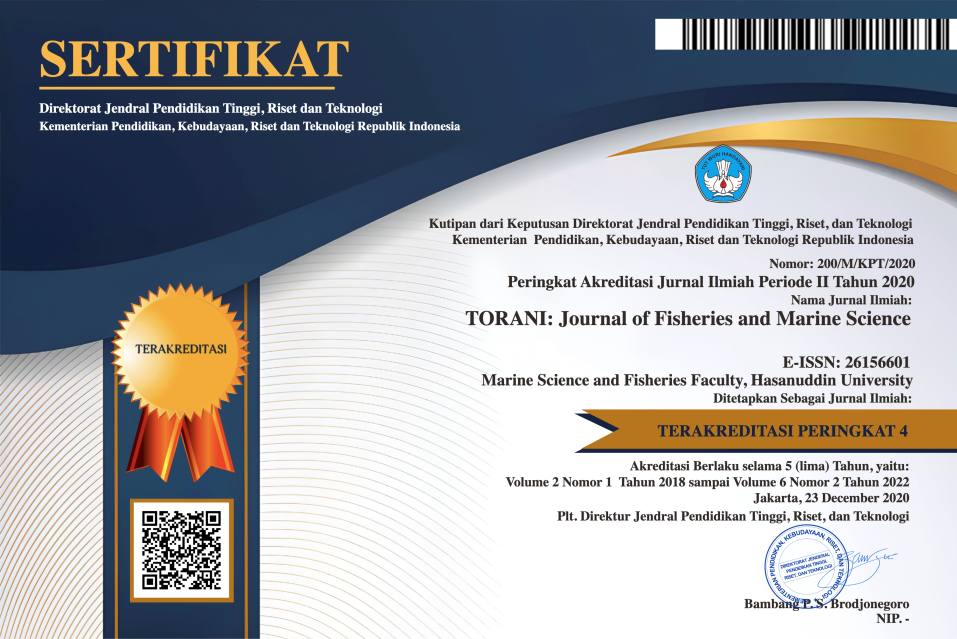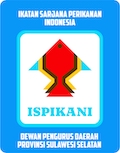The Effect of Combination of Nitrogen and Phosphate Enrichment on the Development of Seaweed Spores (Kappaphycus alvarezii)
DOI:
https://doi.org/10.35911/torani.v6i1.22366Keywords:
Kappaphycus alvarezii, spores, nitrogen, phosphateAbstract
Seaweed (Kappaphycus alvarezii) is one of the aquatic commodities that has the potential to be developed due to demand reaching the international market (Ari, SP and Risna Yusuf, 2018). Provision of seeds is still carried out by vegetative means (cuttings) (Runtuboy N and Slamet Abadi, 2018). However, there are problems, especially the provision of quality seeds, large scale, and does not depend on the season. Provision of seeds can also be done generatively. K. alvarezii can be developed by exploiting the nature of sexual reproduction through the development of spores which are characterized by the presence of cystocarp on the surface of the thallus (Juniarta I, 2016). However, the cystocarp in its growth really needs nutrition in order to produce spores of good quality and quantity. The nutrients needed are nitrogen and phosphate. This is due to the role of nitrogen as a constituent of protein and phosphate as a provider of energy (Pauwah A, et al., 2020). The purpose of this study was to determine the dose ratio of nitrogen and phosphate enrichment on cystocarp development. The research was carried out from November 2018 to February 2019, at the Seaweed Laboratory of the Takalar Brackish Water Aquaculture Fishery Center (BPBAPT). The study contained 6 treatments with 3 repetitions, namely Treatment A = Without enrichment (SW), Treatment B = 0.5 ppm N: 0.5 ppm P, Treatment C = 1 ppm N: 0.5 ppm P, Treatment D = 1.5 ppm N : 0.5 ppm P, Treatment E = 0.5 ppm N : 1 ppm P, and Treatment F = 0.5 ppm N : 1.5 ppm P. The results showed that the highest germination was in treatment D with an average of 56.95%. However, the research was not significantly different between treatments (p>0.05).
References
Akib, A., M. Litaay.,Ambeng., dan M.Asnady. 2015. Kelayakan Kualitas Air Untuk Kawasan Budidaya Eucheuma cottoni Berdasarkan Aspek Fisika, Kimia dan Biologi di Kabupaten Kepulauan Selayar. Jurnal PesisirdanLautTropis. Vol.1 No. 1: 25-36.
Ari Permana S dan Risna Yusuf. 2018. Saluran Pemasaran Rumput Laut (Eucheuma Cottonii) di Sumba Timur, Nusa Tenggara Timur. Jurnal Manina Sosial Ekonomi Kelautan dan Perikanan. Vol 4, No (2). Balai Besar Riset Sosial Ekonomi Kelautan dan Perikanan Gedung BRSDMKP I Lt. 4. Jalan Pasir Putih Nomor 1 Ancol Timur, Jakarta Utara.
Asni A. 2015. Analisis Produksi Rumput Laut (Kappaphycus alvarezii) Berdasarkan Musim dan Jarak Lokasi Budidaya di Perairan Kabupaten Bantaeng. Jurnal Akuakita Vol 6, No (2). Fakultas Perikanan dan Ilmu Kelautan. Universitas Muslim Indonesia. Makassar.
Fattah, N. 2011. Analisis Performa Biologis dan Kualitas Jenis Kappaphycus alvarezii Pada Kondisi Perairan Yang Berbeda. Tesis. Pasca Sarjana. Universitas Hasanuddin. Makassar.
Harwinda, F K, Satyantini W H, and Masithah E W. 2017. The effects of salinity and temperature shock on Kappaphycus alvarezii seaweed spores release. Departement of Fish Health Management and Aquaculture, Faculty of Fisheries and Marine Airlangga University,Surabaya 60115.
Ichsan Andi Nur, Husain Syam , dan Patang. 2016. Pengaruh Kualitas Air Terhadap Produksi Rumput Laut (Kappaphycus alvarezii). Jurnal Pendidikan Teknologi Pertanian, Vol. 2 (2016) : 27-40. Alumni Program Studi Pendidikan Teknologi Pertanian.
Juniarta I, Rajuddin Syamsuddin , Hasni Yulianti Azis, dan Inayah Yasir. 2016. Perkembangan Spora Kappaphycus alvarezii Varietas Hijau Menjadi Tallus Muda pada Substrat Berbeda. Jurnal Rumput Laut Indonesia (2016) 1 (1): 27-33. Pusat Unggulan Ipteks Pengembangan dan Pemanfaatan Rumput Laut (PUI-P2RL) Universitas Hasanuddin.
Khasanah N, Adhika P. Agra Wijnana, dan Maria Ulfa. 2021. Keaneka Ragaman Rumput Laut Nusa Tenggara Timur. Gadjah Mada University Press.
Patang dan Yunarti. 2013. Pengaruh Berbagai Metode Budidaya Dalam Meningkatkan Produksi Rumput Laut. Pangkep.
Pauwah A, M. Irfan , dan Fatma Muchdar. 2020. Analisis Kandungan Nitrat Dan Fosfat Untuk Mendukung Pertumbuhan Rumput Laut Kappahycus Alvarezii Yang Dibudidayakan Dengan Metode Longline Di Perairan Kastela Kecamatan Pulau Ternate Kota Ternate. Jurnal Hemyscyllium Vol. 1 no 1 : 10-22. Program Studi Budidaya Perairan. Universitas Khairun Ternate.
Prasasti C.E. 2016. Pengaruh Konsentrasi Formulasi Zat Pengatur Tumbuh (ZPT) Indole Acetic Acid (IAA) dan Benzyl Adenim (BA) Terhadap Pertumbuhan Kalus Rumput Laut Eucheuma cottonii Melalui Kultur Invitro. Skripsi. Program Sarjana. Universitas Muhammadiyah Malang.
Runtuboy N dan Slamet Abadi. 2018. Optimalisasi Penyediaan Bibit Rumput Laut Kotonii (Kappaphycus alvarezii) Hasil Kultur Jaringan. Jurnal Penyuluhan Perikanan dan Kelautan Volume 12(1) April 2018 Halaman 1-10. Balai Besar Perikanan Budidaya Laut Lampung Jalan Yos Sudarso, Desa Hanura, Padang Cermin, Kabupaten Pesawaran, Lampung.
Setiarini Z dan Endang Listyani. 2017. Analisis Regresi Robust Estimasi-S Menggunakan Pembobot Welsch Dan Tukey Bisquare. Jurnal Matematika Vol 6 No 1. Program Studi Matematika, Jurusan Pendidikan Matematika FMIPA UNY.
Susanto A.B., Rinawati Siregar , Hanisah , Teuku Muhammad Faisal, dan Antonid. 2021. Analisis Kesesuaian Kualitas Perairan Lahan Tambak Untuk Budidaya Rumput Laut (Gracilaria sp.) Di Kecamatan Langsa Barat, Kota Langsa. Journal of Fisheries and Marine Research Vol 5 No 3 (2021) 655-667. Dept. Marine Science, Faculty of Fishery and Marine Science, Diponegoro University, Semarang.
Syamsuddin, R. 2013. SPORE Discharge and Development, and Carrageenan Content Of Seaweed Kappaphycus alvarezii Illuminated With Different Light Colours. Faculty of Marine Sciences and Fisheries, Hasanuddin University. Makassar.















